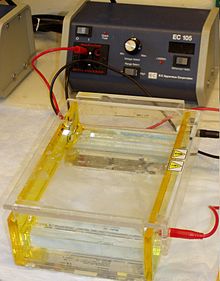Structural Biochemistry/Proteins/Purification/SDS-Polyacrylamide Gel Electrophoresis
SDS-Polyacrylamide Gel Electrophoresis
[edit | edit source]

SDS-Polyacrylamide Gel Electrophoresis is a technique to separate proteins according to electrophoretic mobility - a function of polypeptide chain length or protein mass). SDS-Polyacrylamide Gel Electrophoresis can also be used to separate DNA and RNA molecules.
SDS stands for sodium dodecyl sulfate. "SDS is an anionic detergent that disrupts non-covalent interactions in native proteins." SDS is used to create denaturing conditions to separate proteins by molecular weight and also confers negative charge to the proteins in proportion to its mass. By denaturing the proteins with SDS, proteins can be separated by their mass alone; without SDS, other molecular properties, such as a charge and shape, would interfere with the separation process (proteins that are strongly negative, for example, would move faster down a gel, even if they were larger, without SDS). In addition, a loading dye is introduced that helps bind the protein to the gel and make it more recognizable when exposed by UV light.
SDS-PAGE gives an estimates of the mass of dissociated polypeptides by the anions of SDS binding to the main chains of the polypeptide at a ratio of one SDS anion for every two amino acid residues. SDS-PAGE is unlike sedimentation-equilibrium technique because denaturing of the proteins is applied for SDS-PAGE for mass determination.
This technique is used to test the purity of interest proteins and the percentage of interested protein in the sample solution. This technique is rapid, sensitive and capable of high resolution compared to Gel-Electrophoresis because it can give a distinct band with as little as 0.1 micrograms of the protein when stained with Coomassie Blue and proteins that differ by 2% can still be separated.
SDS-PAGE can also be combined with Isolectric Focusing to obtain very high resolution separations. Proteins are first isolated by their net charge accordingly, then simultaneously run a SDS-PAGE adjacent to the filtering compartment.
Detergents
[edit | edit source]Detergents are widely used to interrupt the hydrophobic interactions which can then destroy the lipid bilayer. Detergents are the most common types of agents used to solubilize transmembrane proteins.
Detergents are small amphiphilic molecules that are more soluble in water than lipids. Sometimes their hydrophilic heads (polar side) can be charged as in SDS but can be nonionic like octylglucoside and Triton. Detergents are monomeric in low concentration but form micelles in high concentration, after overcoming the critical micelle concentration. In order to keep the detergent monomer concentration constant, individual detergents go in and out of micelles. Detergents are very condition specific because they depend on the pH, salt concentration, and the temperature. Therefore detergents are very complicated to study.
Detergents help break the lipid bilayer by acting as a substitute. When the detergents are mixed with the lipids, the hydrophobic part of the detergent attaches to the hydrophobic head of the lipid bilayer making them soluble. If the detergent concentration decreases, the protein would not remain soluble.If more phospholipid were to be introduced, membrane proteins would form liposomes. Since the opposite side of the detergent is polar, the binding brings the membrane proteins into the solution as detergent-protein complexes. In this sense, the detergents acts as a capsule/substitute for the lipid membrane.
SDS, a strong ionic detergent, can solubilize even the most hydrophobic membrane proteins by attacking the hydrophobic core itself, which ultimately denatures the protein and can be used in a procedure known as SDS polyacrylmide-gel electrophoresis. The study of the protein function seems almost frivolous with the protein denatured but studies have showed that the protein can be renatured once the detergents are removed. Detergents are used commercially today to remove stains or proteins that stained clothes. By making the protein soluble, it is able to remove direct and other proteins from the clothes.
BN-Polyacrylamide Gel Electrophoresis
[edit | edit source]Similar to SDS-polyacrylamide gel electrophoresis, blue native-polyacrylamide gel electrophoresis is another useful method of protein purification that has allowed scientists to analyze membrane protein complexes in mitochondria, chloroplasts, microsomes, and bacteria.[1]
References
[edit | edit source]http://www.molecularstation.com/sds-page-gel-electrophoresis/#definition
"Biochemistry." Sixth Edition - Jeremy M. Berg, John L. Tymoczko Lubert Stryer
"Molecular Biology of THE CELL." Fifth edition- Alberts, Johnson, Lewis, Raff, Roberts, Walter
